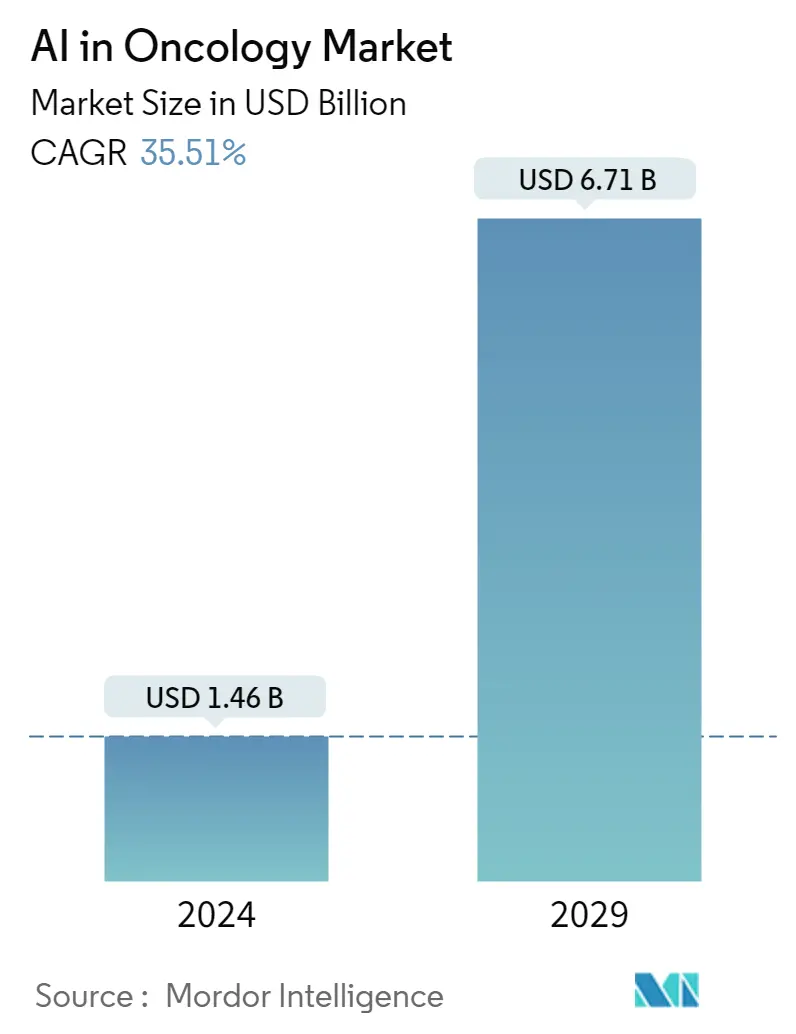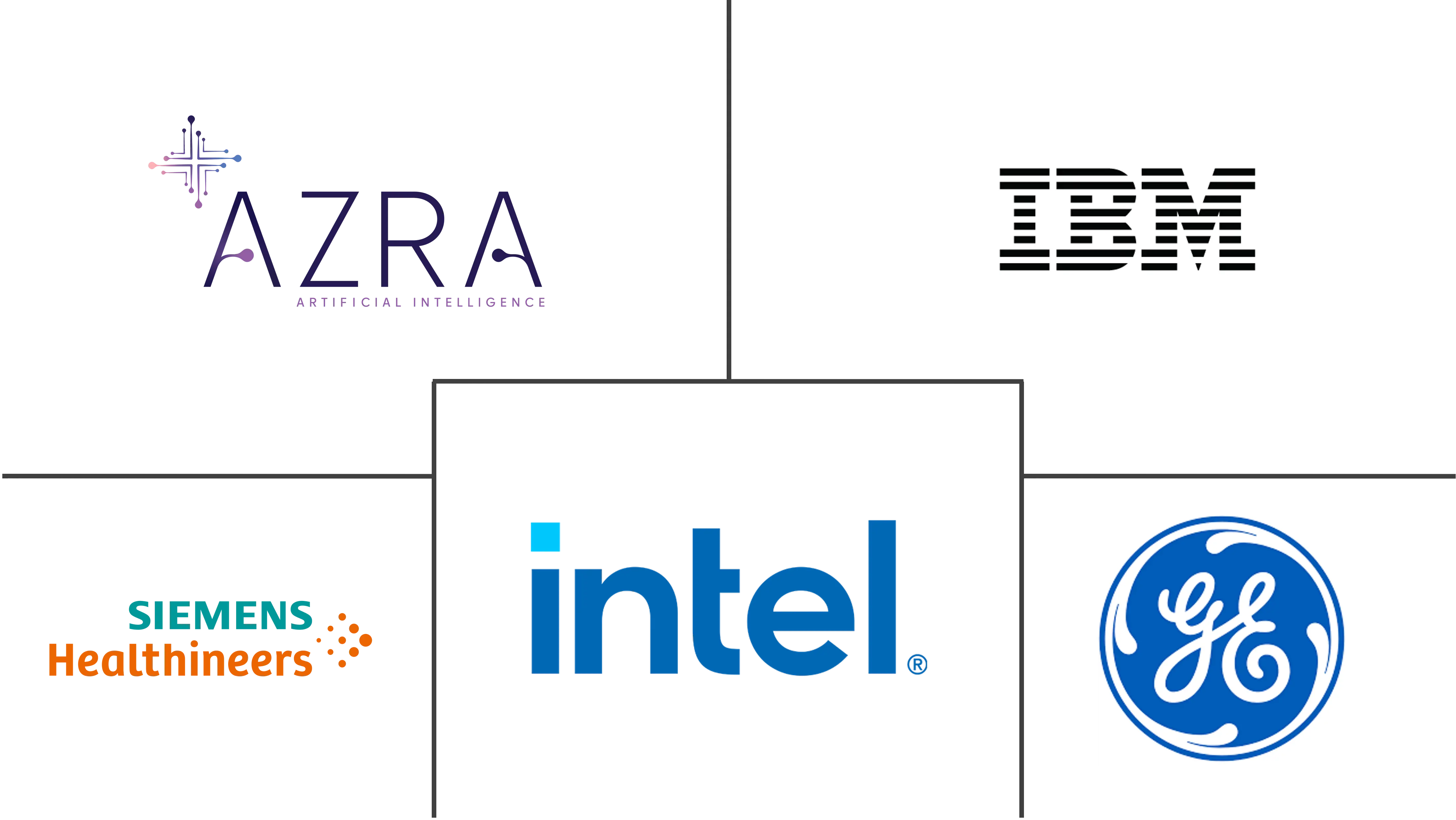Market Size of AI in Oncology Industry

| Study Period | 2019 - 2029 |
| Market Size (2024) | USD 1.46 Billion |
| Market Size (2029) | USD 6.71 Billion |
| CAGR (2024 - 2029) | 35.51 % |
| Fastest Growing Market | Asia-Pacific |
| Largest Market | North America |
Major Players
*Disclaimer: Major Players sorted in no particular order |
AI in Oncology Market Analysis
The AI in Oncology Market size is estimated at USD 1.46 billion in 2024, and is expected to reach USD 6.71 billion by 2029, growing at a CAGR of 35.51% during the forecast period (2024-2029).
One of the main aspects that supported the market growth during the pandemic was the increased adoption of AI to diagnose, treat, and analyze complicated datasets, which helped to minimize the burden on the hospital infrastructure and the physicians. According to the article published by Elsevier in December 2021, the recent advancements in AI and machine learning (ML) boosted the diagnosis and treatment of lung cancer through the utilization of cutting-edge technologies. For instance, the incorporation of clinical and imaging data with ML methods led to the differentiation between lung infections produced by immunotherapy and those produced by the COVID-19 virus.
In addition, the risk of the COVID-19 virus is higher in those already suffering from lung cancer. As per the article published in the Asian Pacific Journal of Cancer Care in November 2020, cancer patients, particularly those with lung cancer, have weaker immune systems, making them more susceptible to COVID-19 and other consequences. Also, due to lockdown restrictions, cancer patient diagnosis, treatment, and care were particularly challenging during the pandemic. Modern AI and ML offer the potential to improve cancer patient diagnosis, care, and therapy in such circumstances.
Furthermore, during the pandemic, AI was employed to manage the backlog of cancer imaging, reducing workloads on healthcare professionals. As per the article submitted by Springer Nature Limited in October 2022, AI was being used for the detection of skin cancer, lung cancer, breast cancer, and cervical cancer to assist in managing the backlog of cancer image analysis that grew as a result of the workforce shortages during the pandemic.
The key factor that is anticipated to propel market expansion over the forecast period is high cancer prevalence all over the world. For instance, as per the American Cancer Society, Inc., there will be around 1.9 million new cancer diagnoses and 609,360 deaths due to cancer in the United States by the end of 2022. Additionally, according to the WHO, in February 2022, lung, breast, rectum, and colon cancers were the most common ones. Furthermore, globally one-third of cancer deaths occur due to the increase in body mass index, high tobacco use, and lack of physical activity. Thus, the rising prevalence of cancer worldwide is likely to boost the adoption of AI for its accurate diagnosis, thereby contributing to the growth of the market studied.
In addition, the expanding healthcare infrastructure advancements worldwide are also propelling the market growth. For instance, in July 2021, the Centre for Fourth Industrial Revolution of the World Economic Forum India announced the launch of the Fourth Industrial Revolution for Sustainable Transformation (FIRST) of the Cancer Care project to focus on advanced technologies like AI, IoT, and blockchain to deliver affordable, easily accessible, and high-quality cancer care in India. Thus, the expansion of healthcare infrastructure is expected to boost market growth during the forecast period.
Furthermore, in recent years, there has been a surge in the adoption of AI in the radiographic imaging of breast cancer for its early detection and diagnosis. Federal agencies have increased the approval of various AI and machine learning (ML) based medical devices for breast cancer diagnosis, which is burgeoning the market growth. For instance, FDA has approved around 178 AI/ML-based medical devices till October 2022, such as Visage Breast Density medical device by Visage Imaging GmbH in January 2021 and Imagio Breast Imaging System by Seno Medical Instruments, Inc., in January 2021. Thus, owing to the active involvement of the FDA in the approval of numerous AI-enabled medical devices is expected to have significant growth over the forecast period.
Therefore, owing to the factors as mentioned above the market studied is anticipated to witness growth over the forecast period. However, high initial costs and concerns over the replacement of the human workforce are likely to impede market growth.
AI in Oncology Industry Segmentation
Oncology uses artificial intelligence (AI) to diagnose cancer more quickly and accurately, which improves patient outcomes and is expected to fuel market growth over the next five years. AI uses computer programs that examine enormous volumes of data to predict cancer. AI applications in oncology may enhance cancer detection, diagnosis, and therapy planning.
The AI in Oncology market is segmented by Component (Software Solutions, Hardware, and Services), Cancer Type (Breast Cancer, Lung Cancer, Prostate Cancer, Colorectal Cancer, Brain Tumor, and Other Cancer Types), Treatment Type (Chemotherapy, Radiotherapy, Immunotherapy, and Other Treatment Types), Application (Cancer Detection, Drug Discovery, Drug Development, and Other Applications), and Geography (North America (United States, Canada, and Mexico), Europe (Germany, United Kingdom, France, Italy, Spain, and Rest of Europe) Asia-Pacific (China, Japan, India, Australia, South Korea, and Rest of Asia-Pacific), Middle East and Africa (GCC, South Africa, and Rest of Middle East and Africa), and South America (Brazil, Argentina, and Rest of South America). The market report also covers the estimated market sizes and trends for 17 countries across major global regions. The report offers the value (in USD million) for the above segments.
| By Component | |
| Software Solutions | |
| Hardware | |
| Services |
| By Cancer Type | |
| Breast Cancer | |
| Lung Cancer | |
| Prostate Cancer | |
| Colorectal Cancer | |
| Brain Tumor | |
| Other Cancer Types |
| By Treatment Type | |
| Chemotherapy | |
| Radiotherapy | |
| Immunotherapy | |
| Other Treatment Types |
| By Application | |
| Cancer Detection | |
| Drug Discovery | |
| Drug Development | |
| Other Applications |
| By Geography | ||||||||
| ||||||||
| ||||||||
| ||||||||
| ||||||||
|
AI in Oncology Market Size Summary
The AI in Oncology market is poised for significant growth, driven by the increasing prevalence of cancer globally and advancements in healthcare infrastructure. The integration of artificial intelligence and machine learning in oncology has been accelerated by the need for efficient diagnosis and treatment solutions, particularly during the COVID-19 pandemic. AI technologies have been instrumental in managing cancer imaging backlogs and improving diagnostic accuracy, especially for lung, breast, and cervical cancers. The market is further bolstered by the active involvement of regulatory bodies like the FDA, which has been approving numerous AI-enabled medical devices, enhancing early detection and diagnosis capabilities. The development of personalized treatment plans through AI, such as tailored chemotherapy dosages, is also contributing to market expansion, offering improved patient outcomes and reducing treatment-related side effects.
North America is expected to dominate the AI in Oncology market due to its robust digital infrastructure and supportive governmental policies. The region's market growth is fueled by strategic collaborations among key players, such as Sanofi-Aventis U.S. LLC and Owkin, Inc., which aim to optimize oncology treatment outcomes through AI advancements. The adoption of AI in oncology is reducing overall treatment costs while maintaining high-quality care, further driving demand. The competitive landscape is characterized by the presence of both international and regional companies, including IBM Corporation, Siemens Healthineers AG, and NVIDIA Corporation, which are actively contributing to market development through innovative solutions and strategic partnerships.
AI in Oncology Market Size - Table of Contents
-
1. MARKET DYNAMICS
-
1.1 Market Overview
-
1.2 Market Drivers
-
1.2.1 Surging Advancements in Healthcare Infrastructure
-
1.2.2 Increasing Prevalence of Cancer
-
1.2.3 Rising Demand for Early and Accurate Diagnosis of Cancer
-
-
1.3 Market Restraints
-
1.3.1 High Initial Costs and Concerns over the Replacement of Human Workforce
-
-
1.4 Porter's Five Forces Analysis
-
1.4.1 Threat of New Entrants
-
1.4.2 Bargaining Power of Buyers/Consumers
-
1.4.3 Bargaining Power of Suppliers
-
1.4.4 Threat of Substitute Products
-
1.4.5 Intensity of Competitive Rivalry
-
-
-
2. MARKET SEGMENTATION (Market Size by Value in USD million)
-
2.1 By Component
-
2.1.1 Software Solutions
-
2.1.2 Hardware
-
2.1.3 Services
-
-
2.2 By Cancer Type
-
2.2.1 Breast Cancer
-
2.2.2 Lung Cancer
-
2.2.3 Prostate Cancer
-
2.2.4 Colorectal Cancer
-
2.2.5 Brain Tumor
-
2.2.6 Other Cancer Types
-
-
2.3 By Treatment Type
-
2.3.1 Chemotherapy
-
2.3.2 Radiotherapy
-
2.3.3 Immunotherapy
-
2.3.4 Other Treatment Types
-
-
2.4 By Application
-
2.4.1 Cancer Detection
-
2.4.2 Drug Discovery
-
2.4.3 Drug Development
-
2.4.4 Other Applications
-
-
2.5 By Geography
-
2.5.1 North America
-
2.5.1.1 United States
-
2.5.1.2 Canada
-
2.5.1.3 Mexico
-
-
2.5.2 Europe
-
2.5.2.1 Germany
-
2.5.2.2 United Kingdom
-
2.5.2.3 France
-
2.5.2.4 Italy
-
2.5.2.5 Spain
-
2.5.2.6 Rest of Europe
-
-
2.5.3 Asia-Pacific
-
2.5.3.1 China
-
2.5.3.2 Japan
-
2.5.3.3 India
-
2.5.3.4 Australia
-
2.5.3.5 South Korea
-
2.5.3.6 Rest of Asia-Pacific
-
-
2.5.4 Middle East and Africa
-
2.5.4.1 GCC
-
2.5.4.2 South Africa
-
2.5.4.3 Rest of Middle East and Africa
-
-
2.5.5 South America
-
2.5.5.1 Brazil
-
2.5.5.2 Argentina
-
2.5.5.3 Rest of South America
-
-
-
AI in Oncology Market Size FAQs
How big is the AI in Oncology Market?
The AI in Oncology Market size is expected to reach USD 1.46 billion in 2024 and grow at a CAGR of 35.51% to reach USD 6.71 billion by 2029.
What is the current AI in Oncology Market size?
In 2024, the AI in Oncology Market size is expected to reach USD 1.46 billion.

